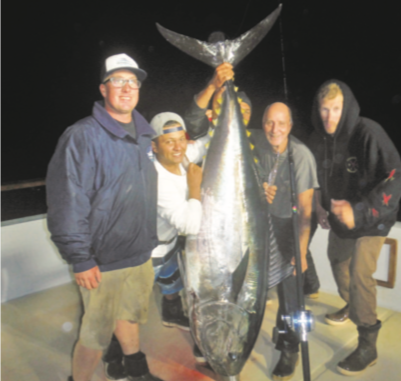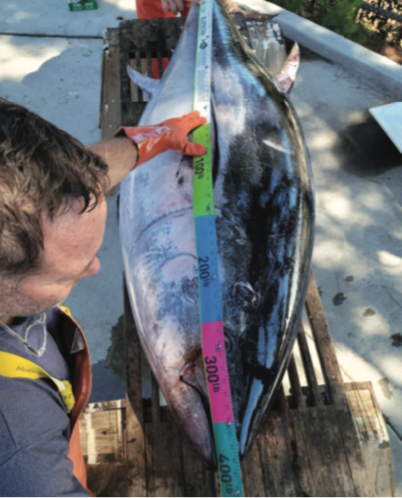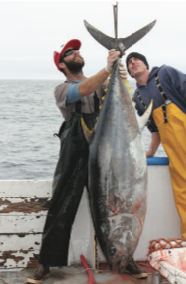EDITOR’S NOTE: This informative article has been condensed and repackaged with a few small additions and some minor edits from a previous four-part series that originally ran in Western Outdoor News in May and June of 2021. The original, in-depth article was a large, collaborative effort with major contributions from longtime charter master Larry Brown, Owyn Snodgrass (NOAA Fisheries Biologist), Theresa Labriola (Wild Oceans Bluefin Tuna Conservation Advocate) and Tim Ekstrom (co-owner and Captain of the Royal Star).
BY LARRY BROWN
With 2021 recognized as one of the best seasons for Pacific bluefin tuna fishing in Southern California on record, we take a deep dive into some fascinating aspects of this amazing fish and its behavior.
They spawn a long way away from here
Spawning of Pacific bluefin tuna (PBFT, Thunnus orientalis) has only been documented in the Western Pacific Ocean (WPO). In the WPO there are two documented spawning grounds, one in the Sea of Japan, and the other in the East China Sea. This is based on the presence of large, mature adult PBFT and the subsequent capture of PBFT eggs, larvae and juveniles shortly thereafter. To date, no evidence of PBFT spawning in the California Current has been documented. Surveys of fish eggs and larvae in the Eastern Pacific Ocean are conducted annually (since 1949, Cal- California Cooperative Oceanic Fisheries Investigations) and have never found PBFT eggs or larvae. To further evaluate whether the large PBFT have been spawning in the EPO in recent years (2014- 2020), NOAA’s Southwest Fisheries Science Center collected go-nads (the reproductive organs: the ovaries and testes) from PBFT up to 350 pounds. Although many tuna are mature by this size, the gonads collected from PBFT brought into to San Diego landings did not show any evidence of PBFT spawning.
Mature fish are pretty big
That really depends on each individual fish. In other words, fish don’t necessarily mature at the same time. Maturity in fish is determined by the presence of enlarged gonads that have eggs (oocytes) for females, and presence of milt (sperm) in males. Studies in the Sea of Japan have determined that 50% of PBFT mature by 5 years of age, or around 150 pounds.
They often undertake huge migrations early in life
The PBFT that migrate into the Eastern Pacific travel across the entire Pacific Ocean from the Western Pacific Ocean (WPO), which is about a 5,000-mile jour- ney one way. The majority of PBFT that migrate to the Eastern Pacific Ocean (EPO) are 1 to 3 years old, or 7 to 30 pounds. There is no evidence that fish migrate at larger sizes, although there has been limited tagging of larger fish in the WPO, which could help answer this question.
It takes two months for baby PBFT to cross the entire Pacific
It is estimated that juveniles make the transoceanic migration from the Western Pacific Ocean (WPO) to the Eastern Pacific Ocean (EPO) in 1.5 to 2 months. The time it takes for fish to swim back to the WPO from the EPO is currently being studied by several organizations. While the exact migration route likely varies a bit from year to year, an unknown percentage of PBFT make migrations into the Southern Pacific Ocean.
We don’t know what they eat while they’re on-the-go…
Little is known about what they eat during their rapid migration across the Pacific. In general, tagging data suggests they are constantly on the move and don’t stop to forage at any one place along their journey for very long. While residing in the California Current, or EPO, they are known to forage on a diverse assemblage of fishes, squids and crustaceans. Like many other tunas, PBFT appear to be forage on whatever is available and most abundant. During the strong El Niño of 2015, a large number of pelagic red crab became available, and that is what we found in most of their stomachs. It all depends on what prey species are available in a given year or season which is likely linked to environmental conditions and larger-scale oceanographic regimes.

But they head to California for the great food
Historically, PBFT are thought to spend between 2 to 5 years in the EPO feeding in the productive waters of the California Current. The amount of time PBFT spend in the EPO likely relates to environmental variables such as available prey, and larger-scale differences in the oceanographic conditions such as El Niño and La Niña events. But we still know very little about what triggers them to return to the WPO.
And they stay for a while
Historically, it was thought that PBFT resided in the EPO for a period of 2 to 5 years after migration from the WPO. In recent years, that trend seems to have changed with PBFT apparently remaining in the EPO for longer than previously thought. Fish up to 10 years of age are being caught in the EPO. These older fish probably arrived in the EPO when they were 1 to 3 years old, suggesting they have spent the last 6 to 9 years in the California Current. This increase in residency is likely due to a combination of factors such as favorable water conditions and prey availability.
They like hanging out at all depths and temperatures
PBFT are able to regulate their internal body temperature, which allows them to dive deeper and spend more time at depth than other more tropical tuna like skipjack and yellowfin tunas. The depth PBFT can inhabit ranges from surface waters to depths of at least 1,700 feet. Typically, PBFT spend most of their time in waters down to 600 feet. Available food and the depth of the thermocline and mixed layer likely dictates where PBFT spend most of their time. The thermo- cline is the depth at which there is a shift from warm surface waters to cool deep waters. The thermocline depth is known to vary from year to year depending on oceanographic conditions. For example, in 2011 Commercial Passenger Fishing Vessels reported very little surface feeding or activity, and usually found PBFT down deep below the thermo- cline in waters from 150 to 300 feet. The lack of shallower forage species like anchovy, sardines and pelagic red crab in 2011 probably influenced their depth distribution. Stomach contents during 2011 suggested PBFT were targeting small fish, squid and crustaceans that are associated with what is called the “deep scattering layer.” Fast forward to 2015 when shallower surface-oriented species like red crab and anchovy became more available, and the majority of PBFT were feeding in surface waters. PBFT can endure temperatures from approximately 44 to 85 degrees Fahrenheit, with their preferred temperature being between 64 to 68 degrees Fahrenheit.

April 8, 2022 – WESTERN OUTDOOR NEWS 33
THE STATE RECORD Pacific bluefin tuna, caught by Floyd Sparks. Weighing in at just under 400 pounds, even bigger fish are ex- pected to come through as populations increase in coming years.
They like feeding at all depths, too
Where PBFT feed depends on what kind of food is available. If there are a lot of epipelagic prey around (surface-oriented fish like anchovy), then they will probably feed near the surface. Alternatively, during the years where there is little visual surface activity or shallower prey around, they are probably feeding deeper in the water column on mid-water prey such as small squid, fish and crustaceans. They can dive quite deep and remain active in colder waters due to evolutionary adaptation that allows them to regulate their internal body temperature. This likely results in them being able to feed throughout their known depth range if prey is encountered.
Seasons might not matter that much
When seasonal water temperatures warm, many fish species become more active and feed more regularly as they devote their energy towards growth. That said, fishing in recent years has been good during all months of the year. For example, the Shogun returned home December 30, 2020 with limits of bluefin tuna from 150 to 350 pounds. Additionally, one of the best bites I ever experienced for smaller bluefin tuna was on the Tribute in February near the Cortes Bank. So personally, I do not think time of year re- ally makes a difference. The lack of boats on the water during winter and spring months might be why there are less PBFT caught during those months. If there are no boats out looking for tuna, then it stands to reason that no tuna will be caught.
Be thankful for the California Current
The California Current is an extremely productive area. The waters of California are characterized by extreme upwelling, which provides ample nutrients for primary production of forage fish, and is referred to as an eastern boundary current. The high productivity of the California Current during years of high up- welling conditions provides nutrients for the base of the food chain, which in turn becomes food for larger pelagic fish, mammals and seabirds to the area due to the large amount of available forage. Recent management measurements are also likely influencing the numbers and size of PBFT encountered by recreationally fishermen in recent years. There is no evidence that localized pollution influences migrations either to or from the EPO.
The overall population is still very low
The stock assessment completed in 2020 concluded that Pacific bluefin tuna is at historic lows (about 4% compared to the biomass if no fishing had taken place). Stock assessments of PBFT are based off the numbers of adult PBFT, or the spawning biomass. The amount and rate of PBFT harvested each year continues to be high. As a result, the population is considered to be overfished and subject to overfishing. An international rebuilding effort is underway to reduce fishing impacts, bring the stock back to healthy levels and ensure the sustainability of future harvests. With the current regulations in place, the population is projected to recover.

But measures are in place to address low population levels
In 2014, Pacific bluefin tuna faced dire straits. Scientists estimated that only 3 percent of the virgin spawning biomass remained in the Pacific. Time was running out to address the continued unsustainable fishing on this highly prized fish. In 2016, the WCPFC and IATTC set a goal to increase the stock to a mere 7 percent of spawning stock bio-mass (or 7 percent of the historic unfished spawning biomass or about 24,000 mt) by 2024. Common sense tells us that leaving so few spawners will not produce a sustainable fishery on a continuing basis. In 2017, managers agreed to a second goal for Pacific bluefin tuna, promising to rebuild the population to 20 per- cent of its pre-fishing levels by 2034. Catch limits were set, targeting a 30% reduction for the commercial and recreational catch in the eastern Pacific to al- low the stock to rebuild.
Despite lower bag limits, landings are increasing…
California Department of Fish and Wildlife sets the recreational Pacific bluefin tuna limits. In 2015, in response to the unprecedented decline of the stock and international agreements to slow fishing, the state adopted a
statewide 2-fish recreational daily bag limit. The change from 10 fish per day to 2 fish per day was expected to generate a 30 percent reduction in catch. With the increased volume of bluefin tuna in local waters, however, recreational landings have increased 25% from 2016 to 2019. More than 400 metric tons were caught in 2019 by recreational anglers, exceeding that of the U.S. commercial fleet and even Taiwan.
And they’re getting bigger!
In the past several years we have seen more and more large bluefin being caught. Even 300- pound bluefin are considered ju- veniles (i.e. not sexually mature). These giant pre-spawners are on the verge of embarking on their return trip to the Sea of Japan to spawn. We’ll need to see many more cycles of big fish heading west, reproducing and sending small fish back our way. Plucking a large bluefin from our waters ends that cycle.
Bluefin might be meaner than yellowfin
Big yellowfin tuna may fight harder than big bluefin tuna, but we wonder if bluefin have a high- er IQ. According to Tim Ekstrom, captain of Royal Star, the highly skilled anglers consistently pull out limits of bluefin, while the less skilled anglers struggled to get any bites at all. Every angler, re- gardless of skill, has to fight for every advantage, employ every skill and proven technique. Then,
even when you do get bit, the bluefin will test you physically and mentally and frequently will leave the angler heartbroken — and unfortunately the least skilled anglers seem to lose more fish even after they are hooked.
Bluefin tuna are box office for anglers
This boom in the PBFT cycle has recruited hundreds of new Southern California recreational anglers, introducing them to the ultimate thrill of fishing for, catching and enjoying as gourmet table fare these amazing pelagic gamefish. In addition, hundreds of experienced recreational an- glers have advanced their skillset and experience pursuing and pulling on these worthy oppo- nents, many of which these past two seasons exceeded the 100-, 200- and 300-pound mark. What an opportunity — and one that by all available information should continue for some time.
The state record was recently broken
The CDFW-approved state record stands at an impressive 395 pounds 6 ounces, caught by Floyd Sparks in 2021 out of San Diego. With fish in the upper 200s and 300-pound range now regularly reported in to Western Outdoor News, we wouldn’t be surprised if this falls again in the coming year ahead. Plus, the Pa- cific sportfishing fleet is getting even better at targeting the giant cows each season with increasing numbers of motivated anglers
getting kitted out for a tuna hunt and going on long-range trips to specifically target trophy-grade fish offshore.
WON would like to thank Larry Brown, Owyn Snodgrass
(NOAA Fisheries Biologist) Theresa Labriola (Wild Oceans BFT Conser- vation Advocate) and Tim Ekstrom (co-owner and Captain of Royal Star) for their help in putting this incredibly informative article together.



